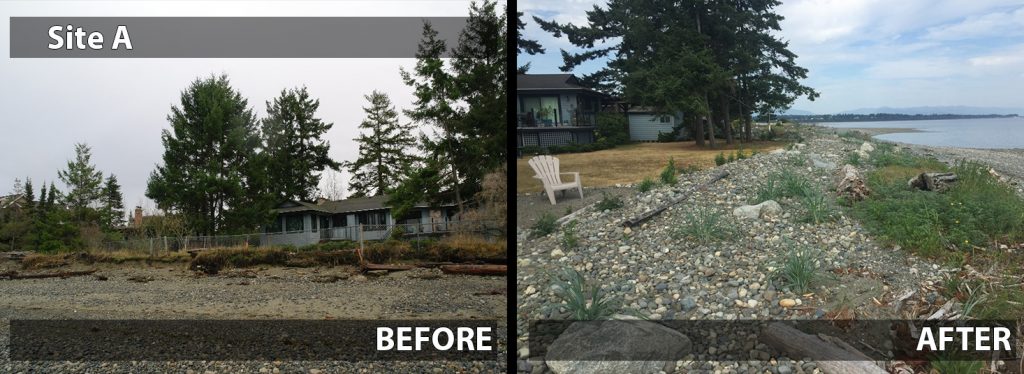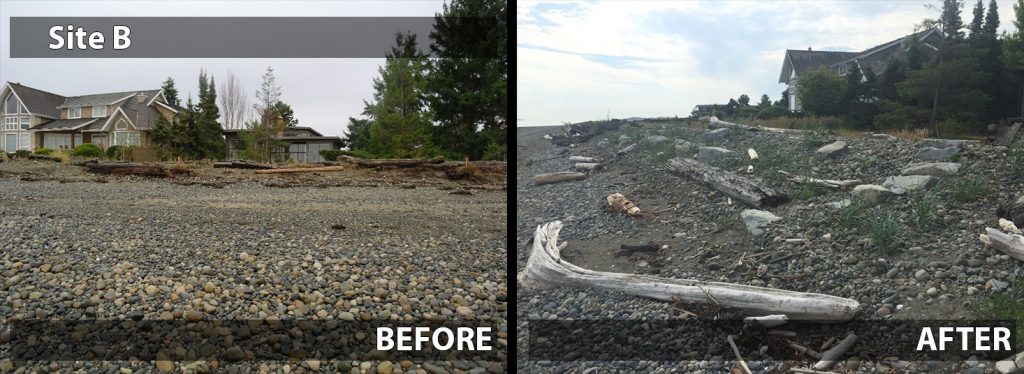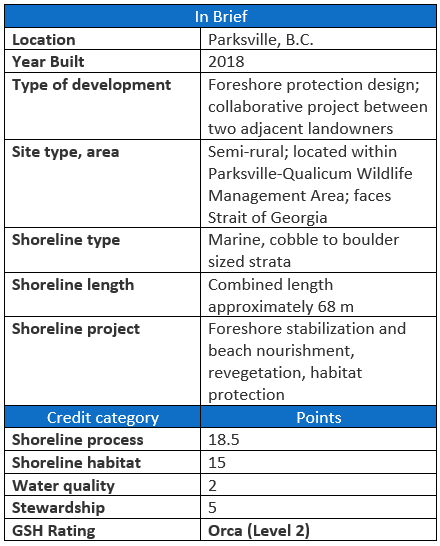Green Shores Case Studies
Mariner Way | Parksville BC


Shoreline type: Cobble and Boulder
Project Team
| Design Build General Contractor | Parksville Heavy Equipment |
| Geotechnical Engineer | Lewkowich Engineering Associates Ltd. |
| Native Plants Supplier | Streamside Native Plants |
Shoreline Issues

This shoreline has a significant length of inter-tidal zone with a flat seabed that extends out to the Strait of Georgia. The low bank beach is gently sloped with cobble to boulder sized material, and is subject to dynamic erosion from both high tide and storm events. Erosion is also impacted by the large wave fetch distance off the Strait of Georgia, and from the consistent prevailing winds.
The upper shore that was being undercut from erosion was regraded to a more natural slope. Along the present natural boundary, a trench with a minimum of 1 metre (3 feet) depth was created, and a layer of geotextile was installed to provide a barrier to the migration of fines during wave and tidal action. Care was taken not to disturb the area beyond the present natural boundary.
Large boulders were placed into the trench to create an armouring revetment. This was followed by infilling with smaller rock similar to the natural beach cobble of the area. Sand and gravel were also added to provide a growing medium for native shoreline plants.
Large woody elements were salvaged and retained on site, before being buried along the upper portion of the natural revetment. This was in keeping with the natural conditions of the local shoreline and provided microsites for plant regrowth. Planting with native species of vegetation including Nootka Rose, Dune grass and Kinnikinnick was completed to complement the Silver Beachweed on site.
Shoreline Physical Processes
Soft shore measures were applied over 50-74% of the shoreline and a plan for monitoring the project was put into place. The project qualified for points for the application of soft shore protection versus hard shore structure protection measures, and was also awarded points for the agreement to have follow-up monitoring of the shoreline improvements for five years.
Shoreline Habitat
About 50% of the riparian buffer was expected to fill in with native vegetation as specified in the planting plan, with the remainder of the buffer to be occupied by exposed boulders, beach rock and woody material. Additional points were awarded for the removal of non-native plant species such as junipers, and for the retention and placement of existing large logs that will dissipate wave energy and provide habitat value.
Water Quality
This project qualified for points through the development of a landscape maintenance plan that specified no synthetic/inorganic pesticides, herbicides or fertilizers in routine landscape management.
Shoreline Stewardship
The Green Shores for Homes project was a collaboration between two adjacent property owners. For public education and outreach, the contractor informed a minimum of 25 neighboring property owners about the project and the foreshore construction activity, through signage, postings at mailboxes, and the provision of brochures to landowners.
